

Every day, commonplace activities that many of us take for granted, such as turning on a light switch or driving to work, consume energy. While an individual’s energy consumption is relatively insignificant, cumulative personal energy consumption, in conjunction with the requirements of the commercial, industrial, and transportation sectors, creates tremendous demand for energy — and meeting that demand is no small task for any country.
Energy independence — not needing to rely on trade to meet domestic demand — is a major priority for most countries because of its consequences for national security, economic sovereignty, and domestic energy prices.
At the same time, because of such factors as infrastructure differences, established trade networks, the quality of natural resources, and the seasonality of energy demand, energy independent countries like the United States are still very active in international energy trade.
For example, while the energy the United States produces exceeds what it consumes, countries like Canada and Mexico both buy and sell oil to the U.S. The U.S. also buys petroleum from the Middle East, for example, and sells oil to the U.K. and Japan.
As an energy independent nation, the U.S. is able to manage these trade partnerships with more leverage. The same, however, cannot be said for many other countries.
Using 2019 energy production and consumption data, 24/7 Wall St. identified the countries that consume more energy than they produce. Countries on this list are ranked by how much more energy they use relative to what they produce based on figures from the Global Energy Statistical Yearbook 2020 by Enerdata, an energy consulting company. We also considered supplemental data from the U.S. Energy Information Administration and BACI, an international trade database.
Fossil fuels like oil, coal, and natural gas accounted for nearly 80% of global energy production in 2019. Though there are some exceptions, most countries on this list depend on trade to meet energy demand because they lack natural resources like oil. Excluding China, no country on this list has more proved oil reserves than Mexico, with an estimated 5.8 billion barrels. For context, the U.S. has the equivalent 68.9 billion barrels in proved reserves. Here is a look at the 15 countries that control the world’s oil.
To overcome a lack of natural resources, countries rely on a mix of energy sources to generate electricity, including nuclear power and power from renewable sources, like wind, solar, and hydro. Still, these sources are generally insufficient to meet energy demand for transportation and industry. Here is a look at the states producing the most renewable energy.
Click here to see 26 countries that consume more energy than they produce.
Click here to read our detailed methodology.
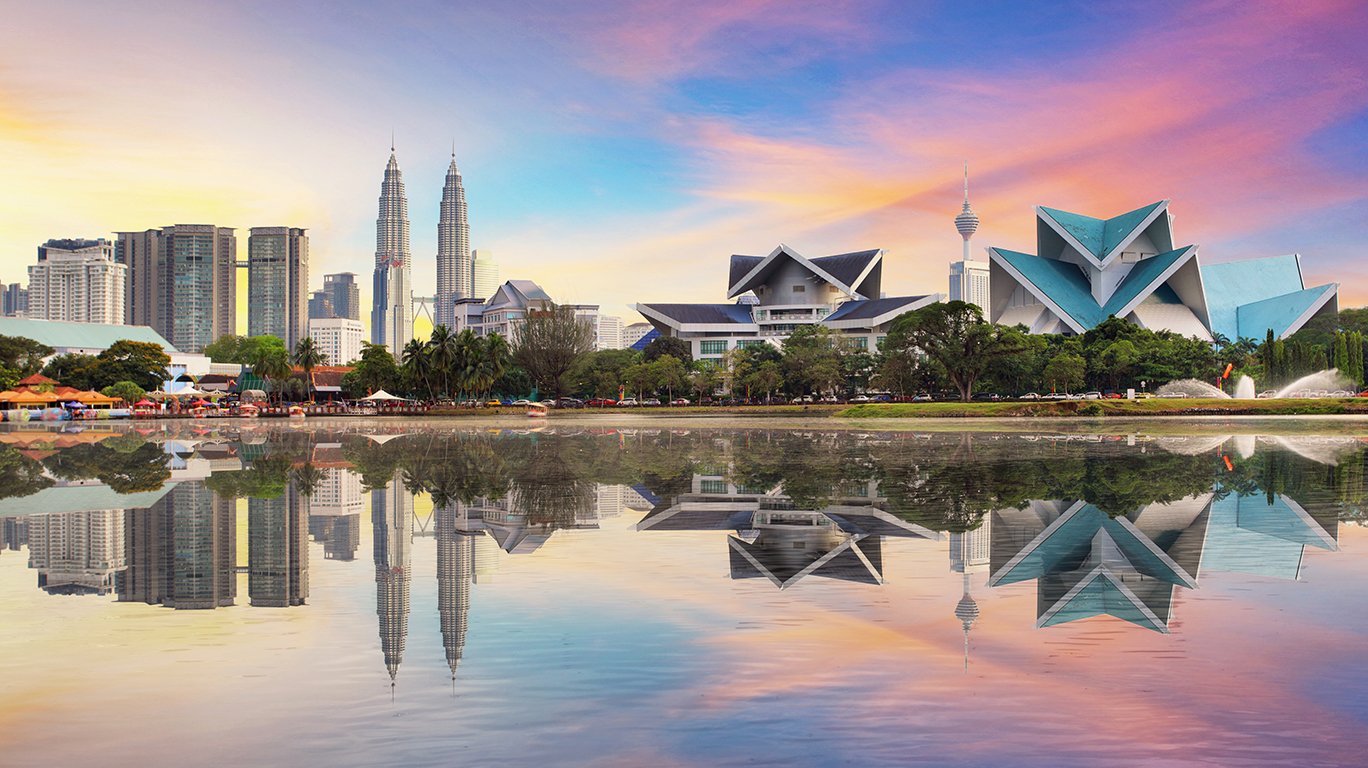
26. Malaysia
> Annual energy consumption: 1,080 terawatt-hours (26th of 44 countries reviewed)
> Annual energy production: 1,066 terawatt-hours (24th of 44 countries reviewed)
> Annual CO2 emissions from fuel combustion: 268.5 tons (24th of 44 countries reviewed)
> Electricity generated from renewable sources: 16.1% (29th of 44 countries reviewed)
> Population: 31.9 million
Malaysia consumes about 1,080 terawatt-hours — about 4% of what the United States consumes — of energy per year, slightly more than it produces. The bulk of energy the Southeast Asian nation generates is from non-renewable, environmentally harmful sources, like oil and natural gas. To meet its energy needs, in 2019, Malaysia also imported $18.1 billion in refined petroleum, $7.0 billion in crude petroleum, and $3.2 billion in coal.
The largest source of renewable energy production in Malaysia comes from hydroelectric power plants. The Bakun plant, located in Sarawak, a state in Malaysian Borneo, is the largest hydro plant in the country and one of the tallest dams in the world.
[in-text-ad]
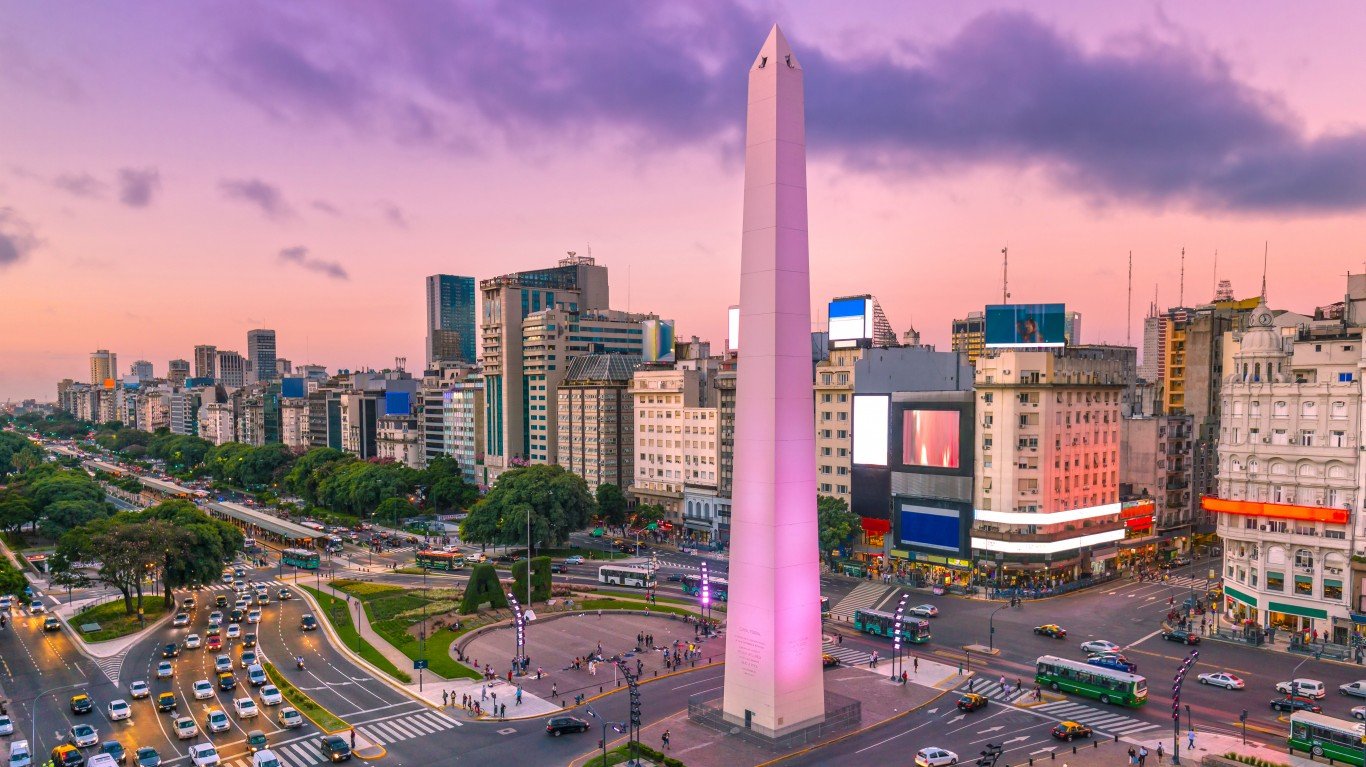
25. Argentina
> Annual energy consumption: 959 terawatt-hours (29th of 44 countries reviewed)
> Annual energy production: 941 terawatt-hours (26th of 44 countries reviewed)
> Annual CO2 emissions from fuel combustion: 188.2 tons (29th of 44 countries reviewed)
> Electricity generated from renewable sources: 31.7% (16th of 44 countries reviewed)
> Population: 44.9 million
With a GDP of over $990 billion, Argentina is one of South America’s largest economies. Annual energy usage in the country — electricity consumption, industrial production, heating and cooling, and other uses — is about 2% higher than the country’s energy resources.
Argentina is doing more than many other countries to transition to renewable electricity production. Nearly one-third of the electricity the country generates comes from renewable sources, especially hydro-electric power. Still, the country imported about $3.8 billion of refined petroleum and petroleum gas in 2019 and emits over 188 tons of CO2 from fossil fuels alone annually.

24. Egypt
> Annual energy consumption: 1,100 terawatt-hours (25th of 44 countries reviewed)
> Annual energy production: 1,077 terawatt-hours (23rd of 44 countries reviewed)
> Annual CO2 emissions from fuel combustion: 236.8 tons (26th of 44 countries reviewed)
> Electricity generated from renewable sources: 10.0% (35th of 44 countries reviewed)
> Population: 100.4 million
Relative to the size of the country, Egypt’s natural resources are relatively scant. As of the end of 2019, the North African country had 3.1 billion barrels of proved oil reserves, more than a number of nations, but a small fraction of what many of its neighbors in the Middle East have. Additionally, the country does not have the infrastructure many other nations do for renewable electricity production. Only about 10% of electricity in the country is generated from renewable sources.
With limited resources and green energy infrastructure, Egypt consumes about 2% more energy than it produces. The country imported nearly $10 billion in refined petroleum, crude petroleum, and petroleum gas in 2019.
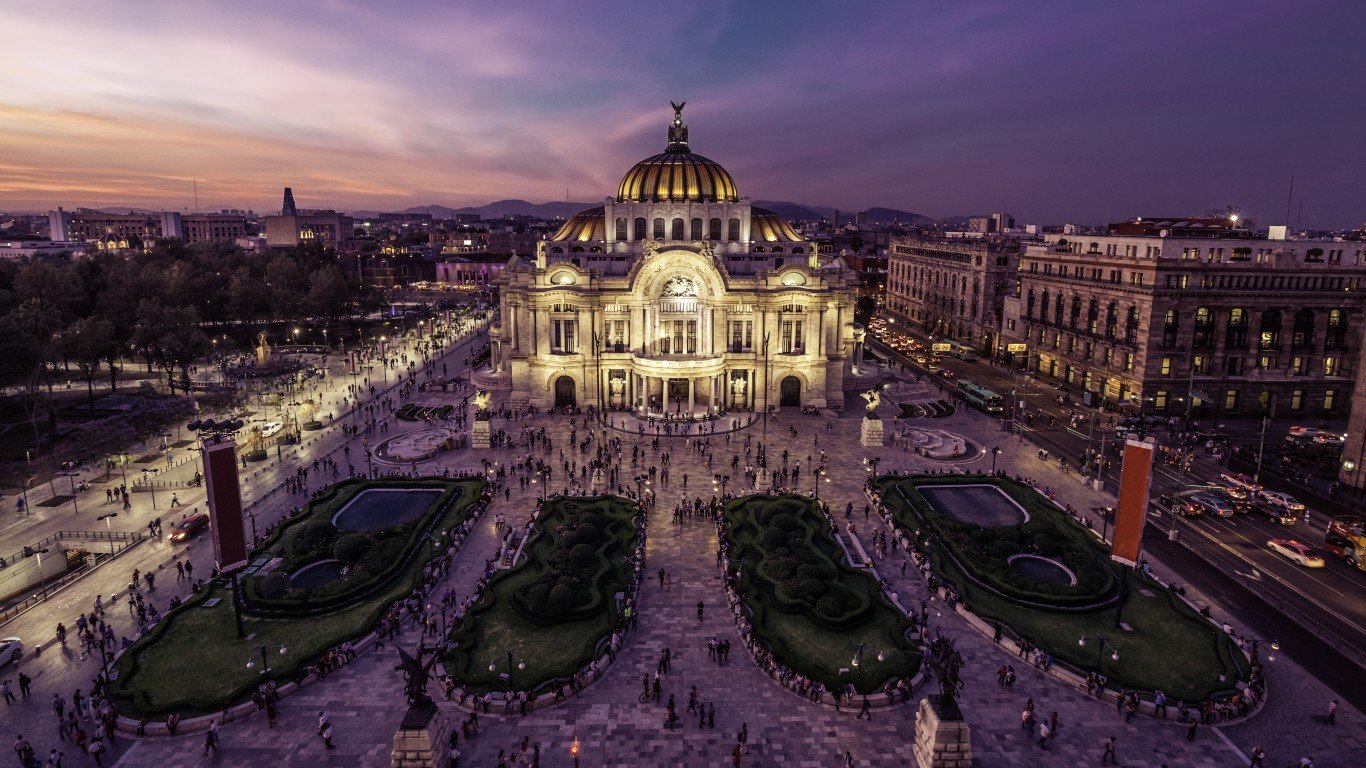
23. Mexico
> Annual energy consumption: 2,065 terawatt-hours (14th of 44 countries reviewed)
> Annual energy production: 1,705 terawatt-hours (17th of 44 countries reviewed)
> Annual CO2 emissions from fuel combustion: 477.6 tons (13th of 44 countries reviewed)
> Electricity generated from renewable sources: 17.5% (27th of 44 countries reviewed)
> Population: 127.6 million
Petroleum fields were first discovered in Mexico in 1900, and over the decades since, the country has evolved into one of the most prolific petroleum producers in the world. Mexico produced an average of 1.9 million barrels of petroleum per day in 2019, according to the EIA. About 17.5% of the country’s electricity is generated through renewable sources — hydroelectricity accounting for the largest share, followed by wind and then solar.
Despite relatively robust energy production, demand for energy in the country of 127.6 million exceeds production. To help compensate, Mexico imported an average of 5.5 billion cubic feet of natural gas from the United States daily in 2019 — 96% of its total natural gas imports.
[in-text-ad-2]

22. China
> Annual energy consumption: 38,188 terawatt-hours (1st of 44 countries reviewed)
> Annual energy production: 31,219 terawatt-hours (1st of 44 countries reviewed)
> Annual CO2 emissions from fuel combustion: 10,724.4 tons (1st of 44 countries reviewed)
> Electricity generated from renewable sources: 27.0% (17th of 44 countries reviewed)
> Population: 1.4 billion
Home to 1.4 billion people, China is the most populous country on Earth. Despite producing in 2019 natural resources equivalent to 31,219 terawatt-hours of energy, the most of any country and nearly 17% more than the U.S., demand for energy exceeds production in China. Energy demand is fueled by rapid economic expansion in China, and in 2019, the country used 38,188 terawatt hours of energy, nearly 50% more than the U.S.
China is also the world’s largest polluter. Despite generating 27% of its electricity from renewable sources, a larger share than most countries reviewed, China emitted more than 10,700 tons of carbon dioxide in 2019 as the country continues to rely on coal. Coal supplied 58% of the country’s energy consumption in 2019, according to the EIA.

21. New Zealand
> Annual energy consumption: 235 terawatt-hours (44th of 44 countries reviewed)
> Annual energy production: 183 terawatt-hours (40th of 44 countries reviewed)
> Annual CO2 emissions from fuel combustion: 36.1 tons (44th of 44 countries reviewed)
> Electricity generated from renewable sources: 81.9% (3rd of 44 countries reviewed)
> Population: 4.9 million
A relatively small country of just 4.9 million people, New Zealand consumed just 235 terawatt-hours of energy in 2019 — less than any of the 44 other countries reviewed. Still, the country relies on foreign trading partners to meet much of that demand and imported about $4 billion in crude and refined petroleum in 2019.
New Zealand’s natural resources include both coal and natural gas — each of which contributes to the country’s energy mix. However, the bulk of New Zealand’s energy demands are met with renewable sources, including hydroelectricity, wind, and geothermal power. Partially as a result, the country has lower carbon emissions than any country reviewed.
[in-text-ad]
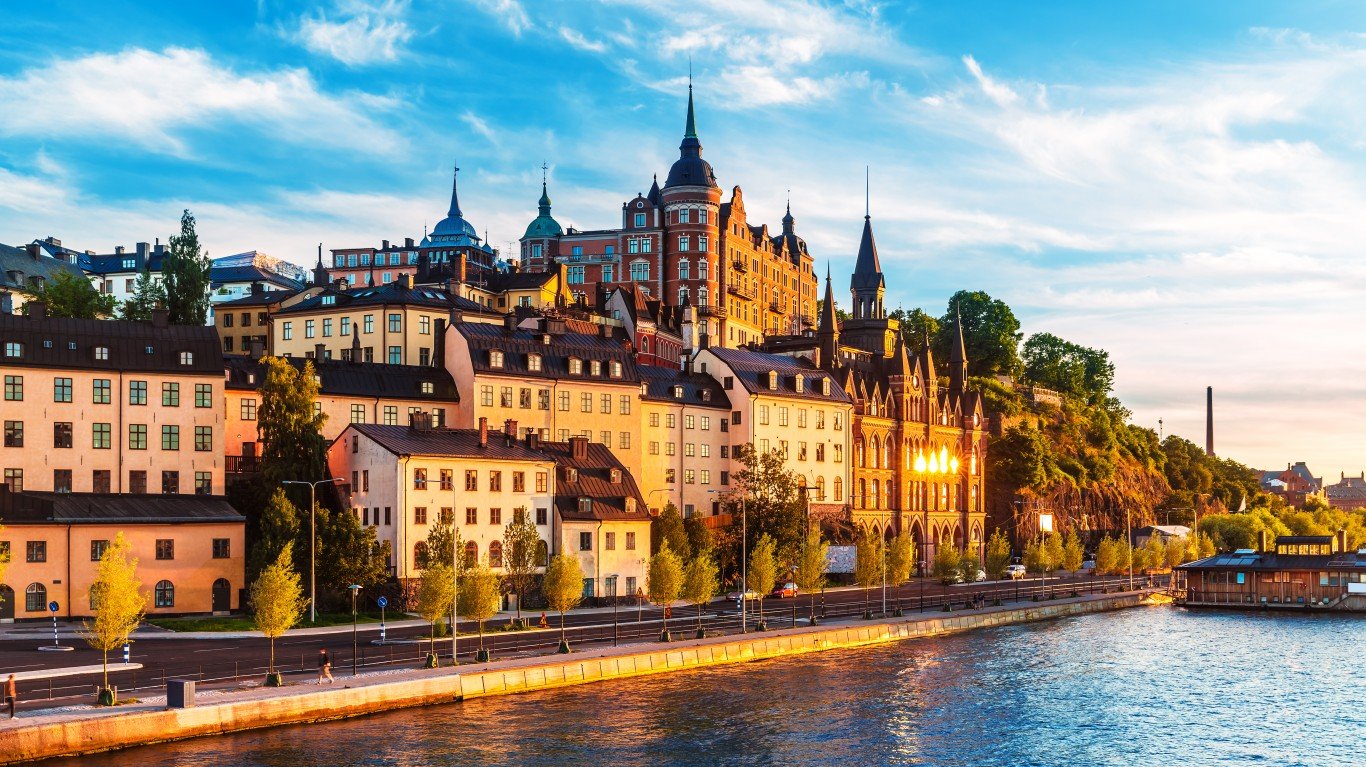
20. Sweden
> Annual energy consumption: 547 terawatt-hours (34th of 44 countries reviewed)
> Annual energy production: 409 terawatt-hours (34th of 44 countries reviewed)
> Annual CO2 emissions from fuel combustion: 43.3 tons (43rd of 44 countries reviewed)
> Electricity generated from renewable sources: 58.7% (7th of 44 countries reviewed)
> Population: 10.3 million
Sweden consumed 547 terawatt-hours of energy in 2019, about 34% more than it produced that year. Without any natural fossil fuel supply, the country generates electricity through both nuclear and hydroelectric power. Both of those sources are low carbon emitters, and partially as a result, Sweden produced 43.3 tons of CO2 in 2019, less than several countries with much smaller populations.
Still, lacking in substantial amounts of natural resources used for power generation, Sweden relies heavily on trading partners to meet energy demand. Two of the country’s top three imports in 2019 by total value were crude petroleum and refined petroleum.
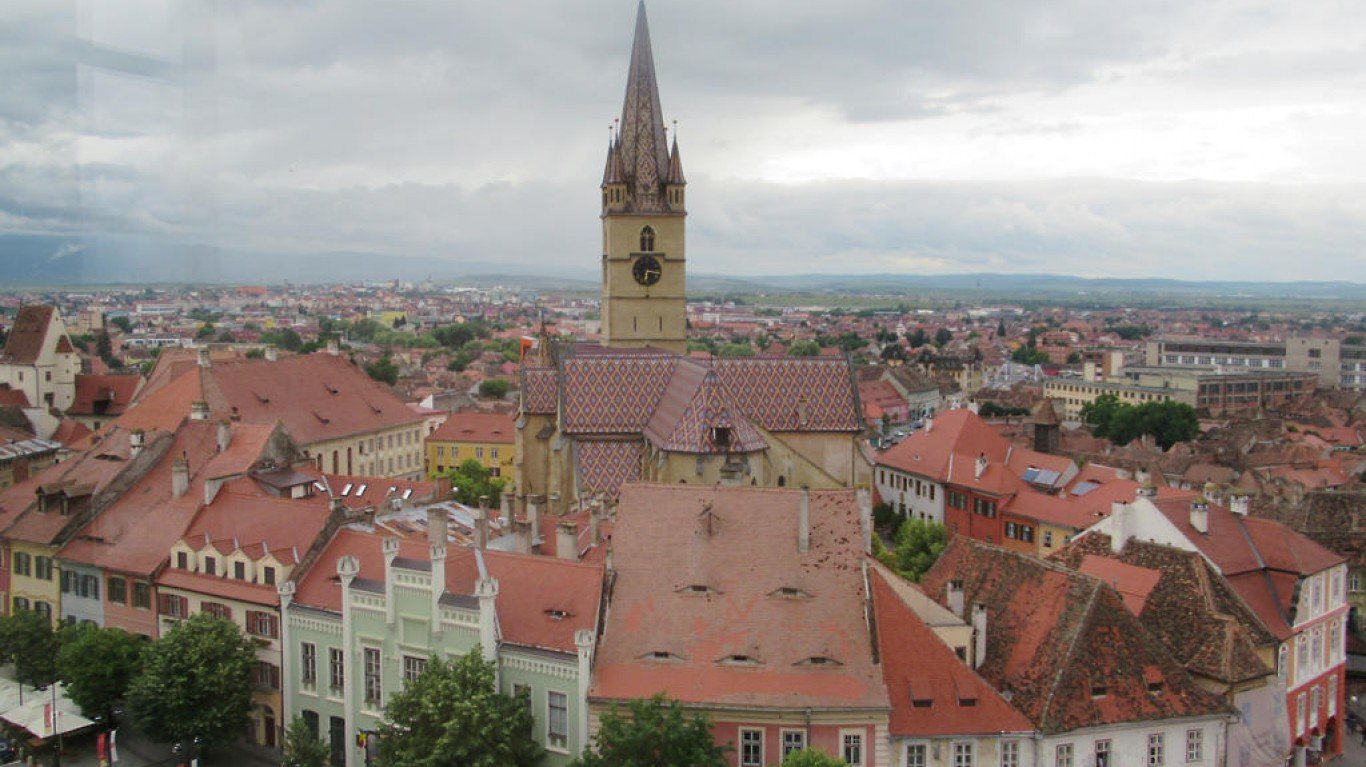
19. Romania
> Annual energy consumption: 393 terawatt-hours (41st of 44 countries reviewed)
> Annual energy production: 292 terawatt-hours (39th of 44 countries reviewed)
> Annual CO2 emissions from fuel combustion: 82.4 tons (40th of 44 countries reviewed)
> Electricity generated from renewable sources: 41.2% (12th of 44 countries reviewed)
> Population: 19.4 million
Romania consumes nearly 35% more energy than it produces. Domestic energy production in the country is a mix of renewable, nuclear, and natural gas sources. To help meet demand, the country imported $2.4 billion in refined petroleum in 2019.
Romania’s two nuclear plants generate about 20% of the country’s electricity and the country outperforms most other European Union member states in renewable energy production. Renewable sources accounted for 23.4% of all energy consumption (and 41.2% of electricity consumption) in the country in 2019 compared to the 18.9% average across the EU. Romania has also committed to a target of 30.5% renewable energy by 2030. Already, the country emits less carbon emissions from fuel combustion than many countries with much smaller populations, including EU partners Belgium and the Czech Republic.

18. United Kingdom
> Annual energy consumption: 1,987 terawatt-hours (15th of 44 countries reviewed)
> Annual energy production: 1,418 terawatt-hours (20th of 44 countries reviewed)
> Annual CO2 emissions from fuel combustion: 381.0 tons (17th of 44 countries reviewed)
> Electricity generated from renewable sources: 37.5% (15th of 44 countries reviewed)
> Population: 66.8 million
The United Kingdom, like many other countries with highly advanced economies, is one of the world’s biggest energy consumers. To meet demand, the country’s domestic energy mix is predominantly a combination of oil, natural gas, coal, and nuclear power. Nuclear power accounts for about one-fifth of electricity generation in the country, and renewable sources account for over a third.
The U.K.’s transportation and industrial sectors drive up demand for energy, and to meet that demand, the country imported nearly $45 billion in both refined and crude petroleum in 2019. Imported crude oil in the U.K. comes primarily from Norway as well as Nigeria, Algeria, and Russia.
[in-text-ad-2]
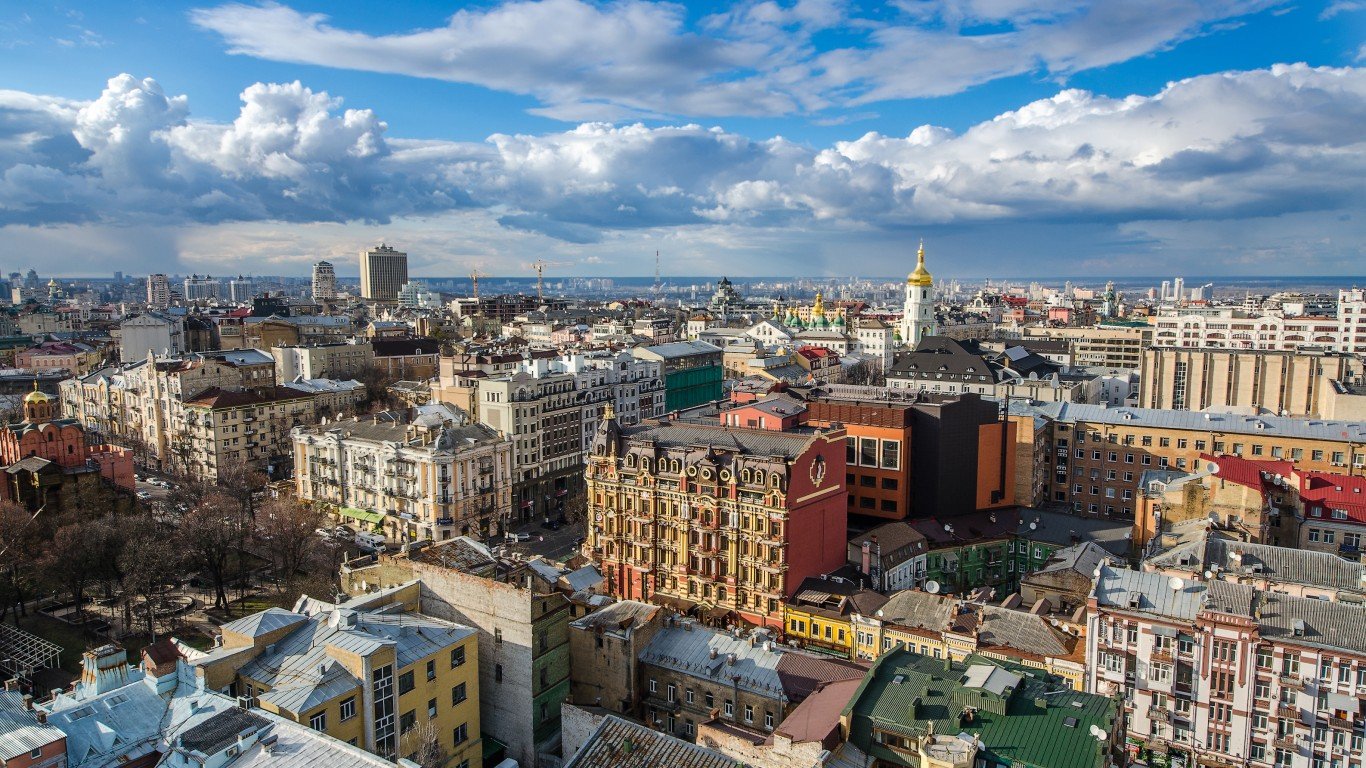
17. Ukraine
> Annual energy consumption: 1,032 terawatt-hours (27th of 44 countries reviewed)
> Annual energy production: 697 terawatt-hours (29th of 44 countries reviewed)
> Annual CO2 emissions from fuel combustion: 194.7 tons (28th of 44 countries reviewed)
> Electricity generated from renewable sources: 7.2% (37th of 44 countries reviewed)
> Population: 44.4 million
The former Soviet country of Ukraine consumes about 48% more energy than it produces. Unlike many other countries that rely on imports to meet energy demand, Ukraine has considerable natural resources. The country is home to some of the deepest coal mines in Europe, and as a Soviet member state, Ukraine was a major petroleum and natural gas producer. In addition to fossil fuels, nuclear power accounts for a large share of the country’s energy, even though the country is home to Chernobyl, the site of what was perhaps the worst nuclear disaster in history.
To meet energy demand, Ukraine imported $4.3 billion in refined petroleum in 2019, more than any other import that year.
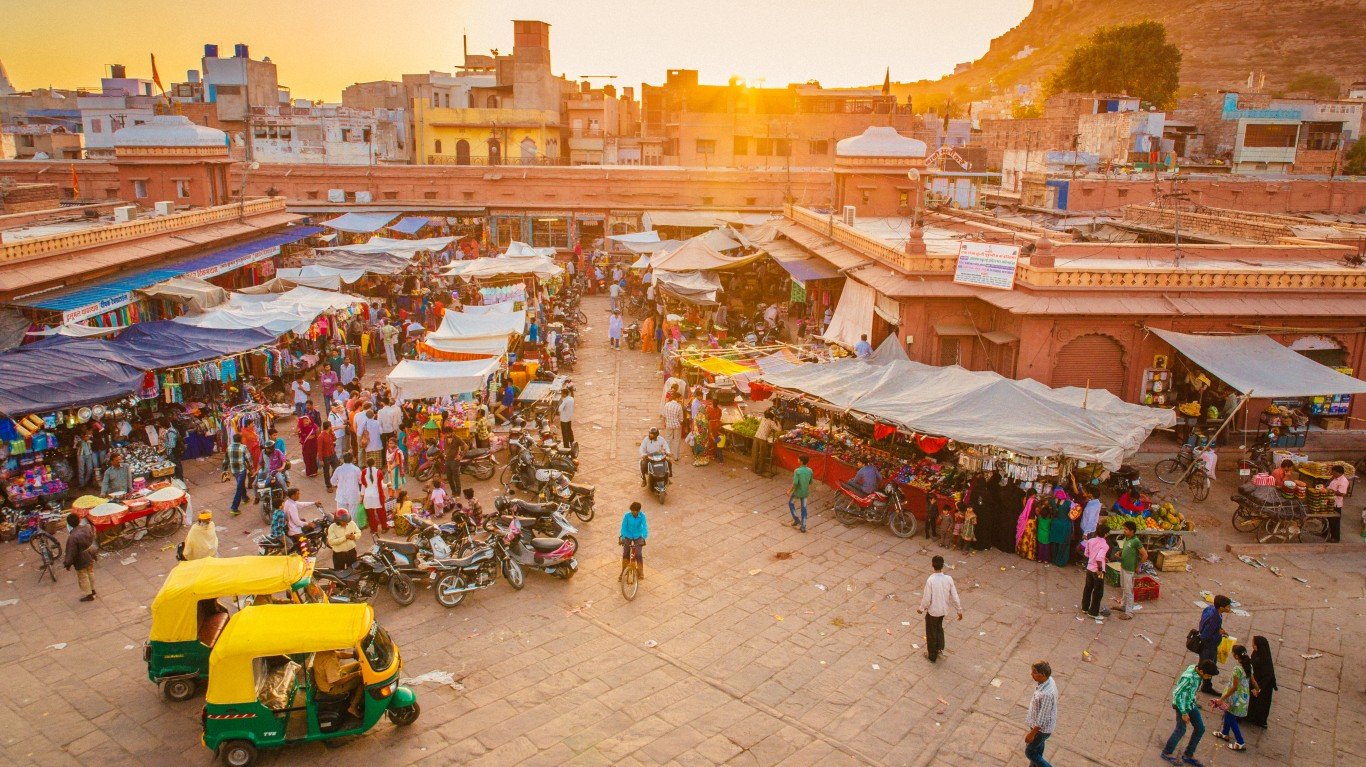
16. India
> Annual energy consumption: 10,621 terawatt-hours (3rd of 44 countries reviewed)
> Annual energy production: 6,707 terawatt-hours (5th of 44 countries reviewed)
> Annual CO2 emissions from fuel combustion: 2449.6 tons (3rd of 44 countries reviewed)
> Electricity generated from renewable sources: 20.7% (19th of 44 countries reviewed)
> Population: 1.4 billion people
Home to nearly 1.4 billion people, India is the second most-populous country in the world, after China, and the third largest energy consumer, after China and the United States. Energy production in the country is not nearly strong enough to meet demand, and the gap between production and consumption shows no signs of closing. As a result, India imports over $100 billion in crude petroleum, coal, and petroleum gas annually, mostly from the Middle East.
Coal accounts for the bulk of India’s energy consumption, followed by petroleum and biomass. Construction projects across India rely on coal as fuel, and many of those projects were halted during the COVID-19 pandemic. As a result, coal consumption may have dipped in the country in 2020, a break from the longer-term trend.
[in-text-ad]
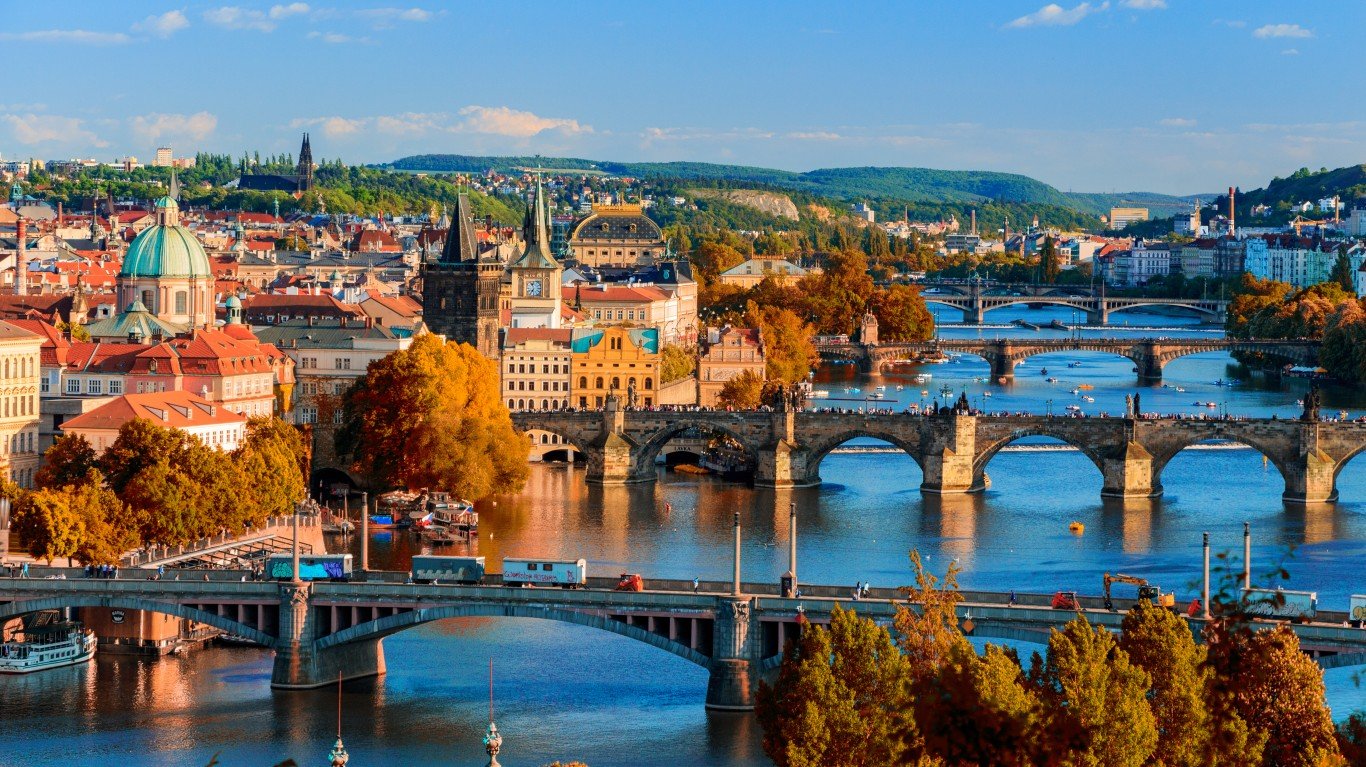
15. Czech Republic
> Annual energy consumption: 502 terawatt-hours (35th of 44 countries reviewed)
> Annual energy production: 311 terawatt-hours (38th of 44 countries reviewed)
> Annual CO2 emissions from fuel combustion: 109.9 tons (32nd of 44 countries reviewed)
> Electricity generated from renewable sources: 12.8% (31st of 44 countries reviewed)
> Population: 10.7 million
Aside from coal and small amounts of petroleum and natural gas, the Czech Republic has relatively limited natural resources for power generation. As a result, the central European nation relies heavily on nuclear power plants and imported fuel.
The first nuclear reactor opened in the Czech Republic in 1985. Today, there are half a dozen nuclear reactors in the country, generating about 33% of the country’s electricity. Going forward, the Czech Republic will look to expand its nuclear production capability substantially. The country also imported nearly $7 billion in refined petroleum, crude petroleum, and petroleum gas in 2019.
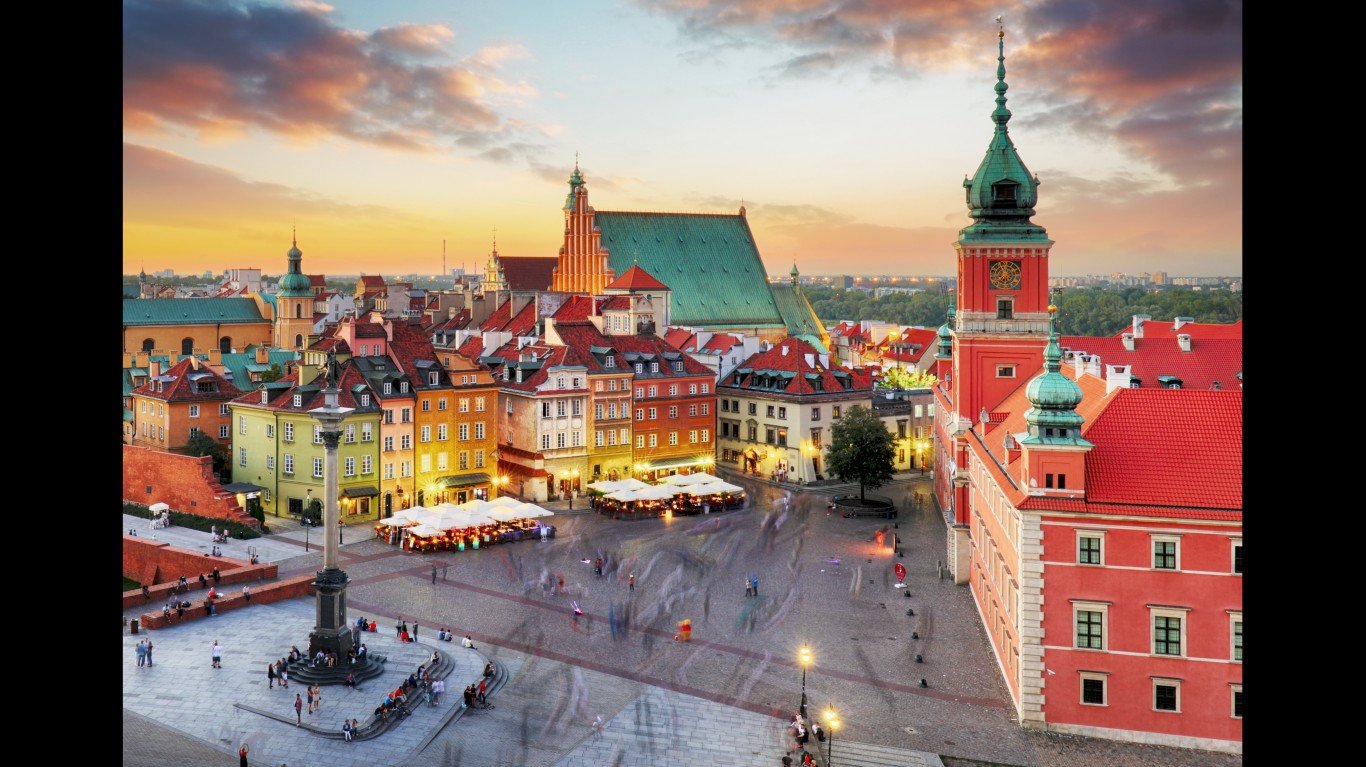
14. Poland
> Annual energy consumption: 1,195 terawatt-hours (24th of 44 countries reviewed)
> Annual energy production: 690 terawatt-hours (30th of 44 countries reviewed)
> Annual CO2 emissions from fuel combustion: 333.0 tons (19th of 44 countries reviewed)
> Electricity generated from renewable sources: 15.8% (30th of 44 countries reviewed)
> Population: 38.0 million
Poland’s energy use exceeds its production by over 70%. Like many other countries that are net importers of energy, Poland does not have large scale oil reserves. The country, however, is the second largest coal producer in Europe after Germany. But due to declining coal prices, coal production in the country has fallen each year in the country for the better part of a decade. Demand for coal in the country is driven by electric power utility companies — coal generates nearly three-quarters of Poland’s electricity, according to the EIA.
With limited oil production capability, Poland imported $10 billion in crude petroleum in 2019, more than any other commodity other than cars.

13. France
> Annual energy consumption: 2,807 terawatt-hours (12th of 44 countries reviewed)
> Annual energy production: 1,538 terawatt-hours (19th of 44 countries reviewed)
> Annual CO2 emissions from fuel combustion: 332.7 tons (20th of 44 countries reviewed)
> Electricity generated from renewable sources: 20.5% (20th of 44 countries reviewed)
> Population: 67.1 million
Lacking in natural resources used in power generation, France produces very little crude oil. To meet demand for fossil fuels, the country imported over $40 billion in crude and refined petroleum in 2019. The country also implemented a ban on hydraulic fracturing in 2011, and as a result, imported $12.7 billion in natural gas in 2019.
Unlike many countries on this list, however, France is a net exporter of electricity. The country is the second largest producer of nuclear power in the world, after the United States, and the low cost of nuclear energy production has made France the world’s top exporter of electricity. Still, accounting for all forms of energy, including electricity, France consumes far more than it produces.
[in-text-ad-2]

12. Thailand
> Annual energy consumption: 1,657 terawatt-hours (19th of 44 countries reviewed)
> Annual energy production: 878 terawatt-hours (27th of 44 countries reviewed)
> Annual CO2 emissions from fuel combustion: 299.2 tons (22nd of 44 countries reviewed)
> Electricity generated from renewable sources: 20.1% (22nd of 44 countries reviewed)
> Population: 69.6 million
Though Thailand does have some proved crude oil reserves, they are declining, and as a result, the country is increasingly relying on trade to meet demand. And while the country is continually increasing its natural gas output, production does not match consumption. Thailand imported $18.3 billion in crude petroleum — more than any other commodity — and another $7.1 billion petroleum gas in 2019.
For electricity production, Thailand uses renewable sources like biomass, hydro power, and solar. The country also often imports electricity from neighboring Laos and Malaysia to help meet demand.
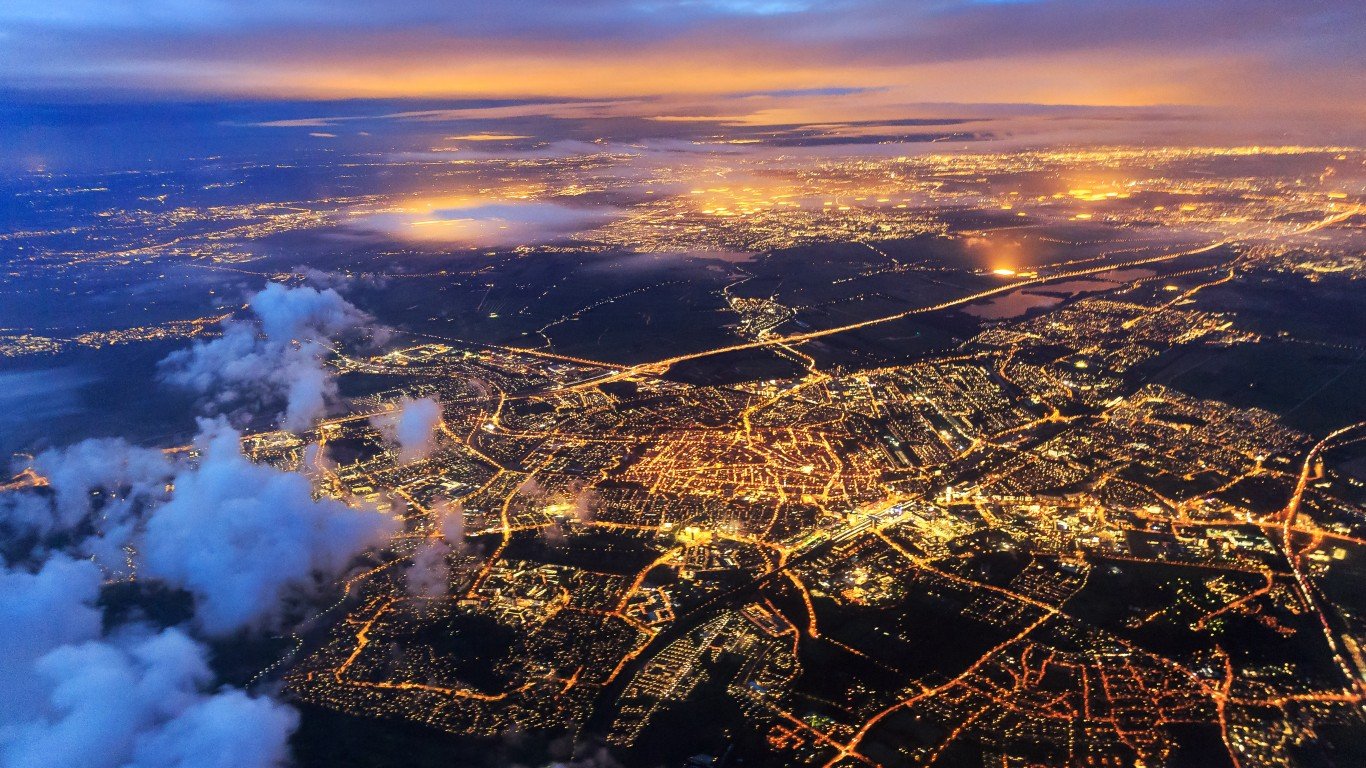
11. Netherlands
> Annual energy consumption: 827 terawatt-hours (30th of 44 countries reviewed)
> Annual energy production: 384 terawatt-hours (37th of 44 countries reviewed)
> Annual CO2 emissions from fuel combustion: 187.9 tons (30th of 44 countries reviewed)
> Electricity generated from renewable sources: 17.4% (28th of 44 countries reviewed)
> Population: 17.3 million
The Netherlands is Europe’s second largest producer of natural gas. Natural gas and coal account for over three-quarters of electricity produced in the country. Still, though the country serves as a transportation, storage, and refining hub for petroleum, the Netherlands produces very small quantities of liquid fuel.
To meet energy demand, the Netherlands is a net importer of petroleum. Combined, refined, and crude petroleum accounted for over 15% of the country’s total import value of over half a trillion dollars in 2019.
[in-text-ad]
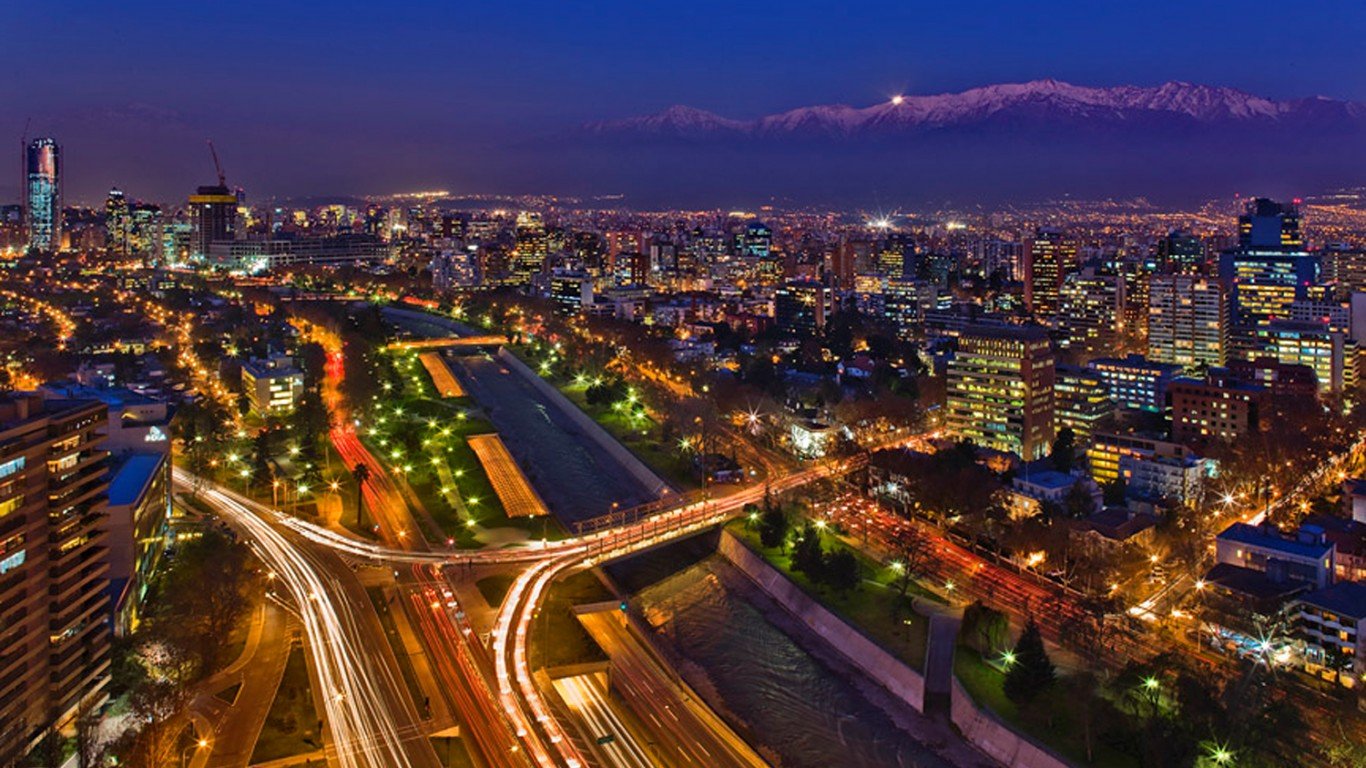
10. Chile
> Annual energy consumption: 456 terawatt-hours (37th of 44 countries reviewed)
> Annual energy production: 160 terawatt-hours (42nd of 44 countries reviewed)
> Annual CO2 emissions from fuel combustion: 95.3 tons (38th of 44 countries reviewed)
> Electricity generated from renewable sources: 45.1% (9th of 44 countries reviewed)
> Population: 19.0 million
Unlike many of its South American neighbors, Chile is not a major producer of fossil fuels, and as a result it relies more on trade to meet energy demand. The country imported $4.2 billion of refined petroleum in 2019, more than any other commodity. It also imported $3.6 billion worth of crude petroleum, and $1.5 billion worth of petroleum gas.
Like some other countries with limited natural resources, Chile generates a considerable share of its electricity — 45.1% — from renewable sources.
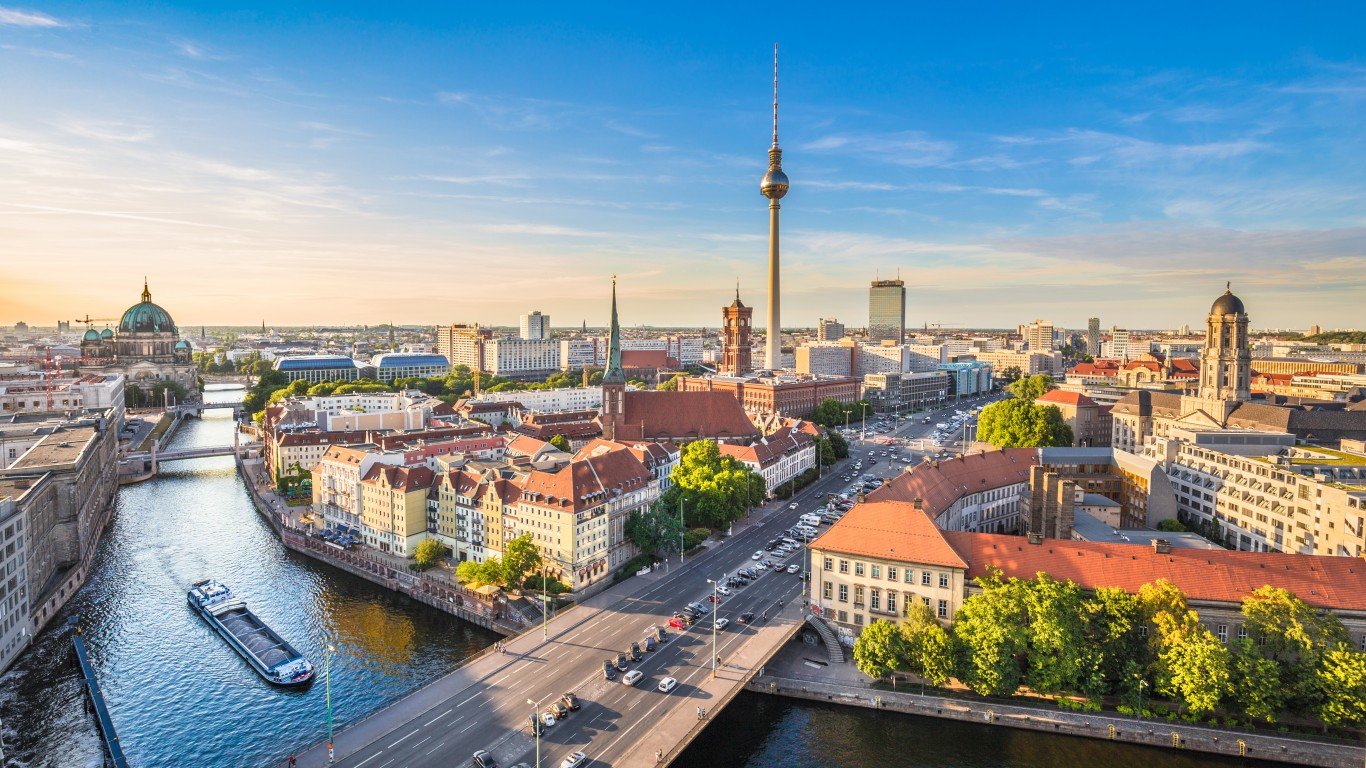
9. Germany
> Annual energy consumption: 3,437 terawatt-hours (7th of 44 countries reviewed)
> Annual energy production: 1,202 terawatt-hours (22nd of 44 countries reviewed)
> Annual CO2 emissions from fuel combustion: 741.8 tons (6th of 44 countries reviewed)
> Electricity generated from renewable sources: 41.2% (11th of 44 countries reviewed)
> Population: 83.1 million
Germany is the largest consumer of energy in Europe. It is far from being the continent’s largest energy producer, however, trailing Norway, France, and the United Kingdom. Germany imported over 70% of the energy it consumed in 2019.
Currently, over 41% of electricity produced in Germany is generated through renewable sources. That share will likely increase in the coming years as the country is in the early stages of a long-term initiative to reduce its carbon emissions. The multipronged approach includes phasing out coal, the country’s most common energy resource, by 2038, closing nuclear power plants, and expanding renewable energy infrastructure.
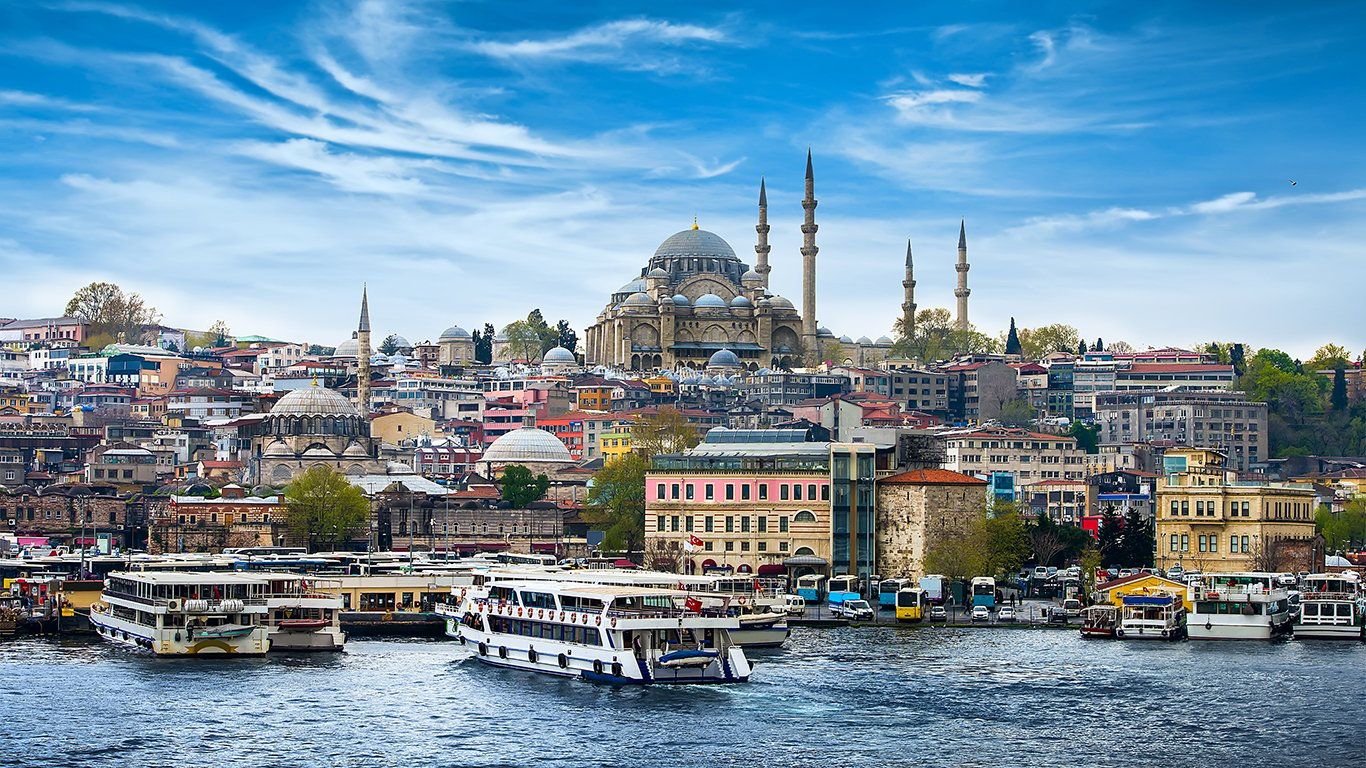
8. Turkey
> Annual energy consumption: 1,710 terawatt-hours (18th of 44 countries reviewed)
> Annual energy production: 556 terawatt-hours (33rd of 44 countries reviewed)
> Annual CO2 emissions from fuel combustion: 415.4 tons (16th of 44 countries reviewed)
> Electricity generated from renewable sources: 44.2% (10th of 44 countries reviewed)
> Population: 83.4 million
Due to its geographic location — notably its proximity to the Black Sea and the Middle East — Turkey is a transit hub for oil and natural gas. Though the country is crisscrossed with pipelines moving vast quantities of fossil fuels, Turkey itself is not a major producer of petroleum. The vast majority of liquid fuel the country consumes is imported from trading partners including Iran, Iraq, and Russia.
Electricity in Turkey is largely produced through coal and natural gas. Though renewable sources account for over 44% of electricity production in the country. The country will soon begin incorporating nuclear power into its energy mix with three plants slated to go online in the coming years. The first plant, located in Akkuyu on the coast of the Mediterranean Sea, is expected to begin operations as early as 2022.
[in-text-ad-2]
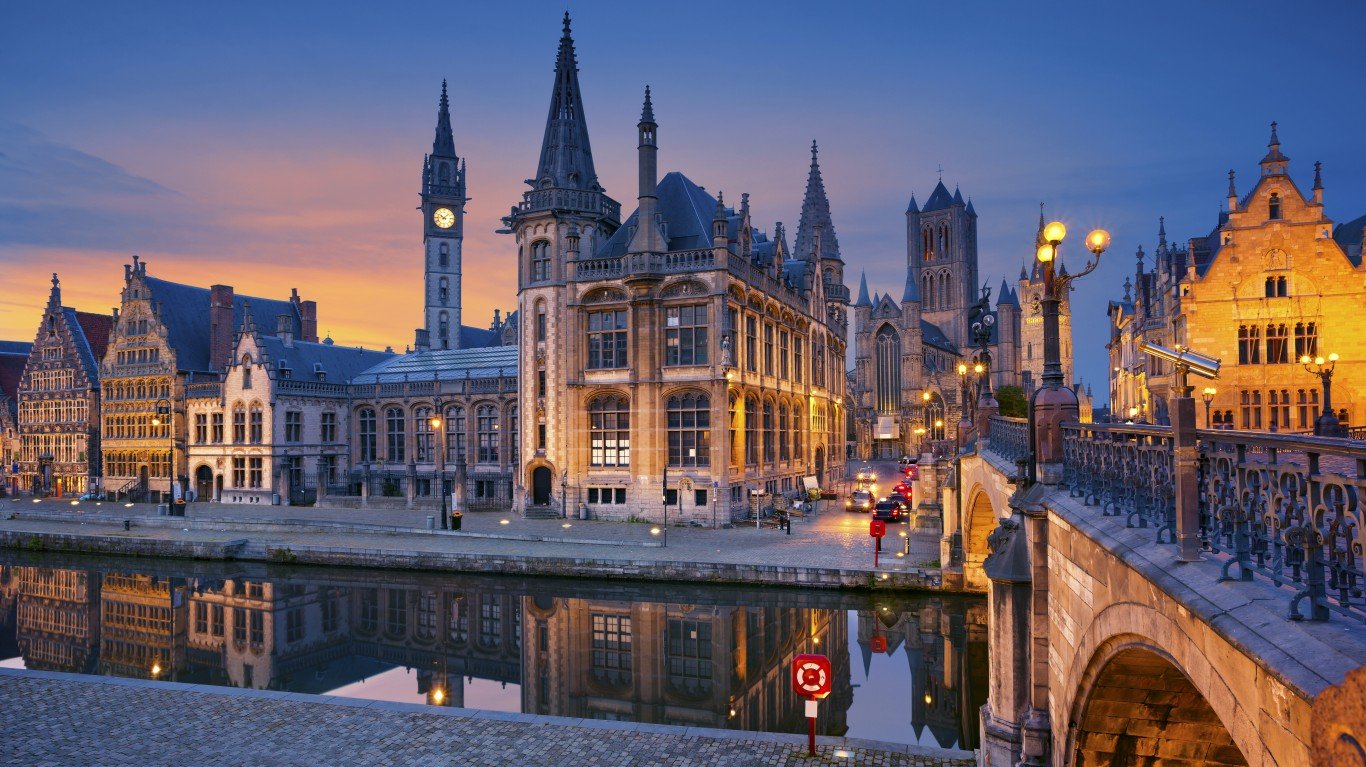
7. Belgium
> Annual energy consumption: 637 terawatt-hours (33rd of 44 countries reviewed)
> Annual energy production: 182 terawatt-hours (41st of 44 countries reviewed)
> Annual CO2 emissions from fuel combustion: 108.0 tons (33rd of 44 countries reviewed)
> Electricity generated from renewable sources: 21.3% (18th of 44 countries reviewed)
> Population: 11.5 million
Belgium is one of several European countries that consumes many times more energy than it produces. While Belgium does produce some oil, it produces no natural gas and negligible amounts of coal. Belgium imported $8.5 billion of petroleum gas in 2019.
While Belgium consumes more energy than it produces, it is one of the few countries on this list that produces more electricity than it consumes. About 20% of electricity produced in the country comes from renewable sources, and about half comes from nuclear power plants. The first nuclear facility in Belgium opened in 1974, and now there are seven nuclear generators operating in the country.
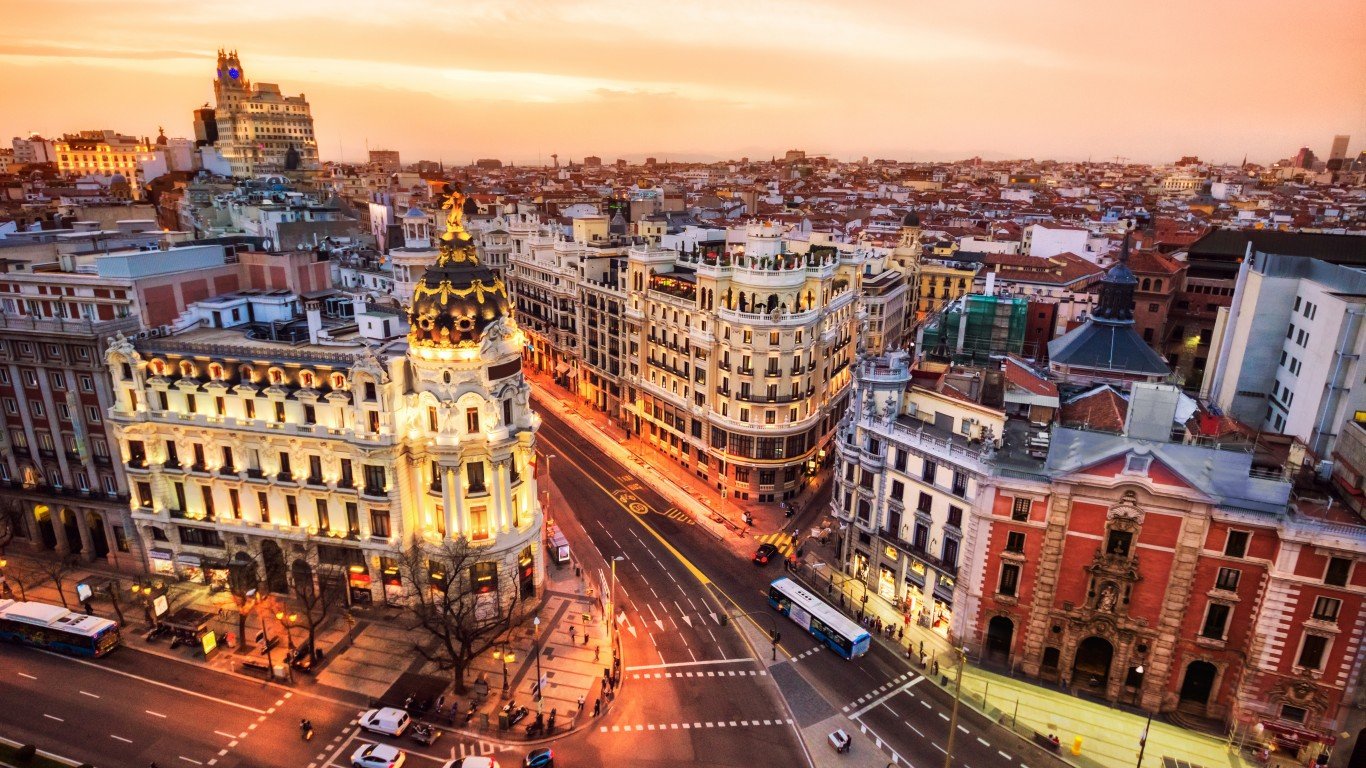
6. Spain
> Annual energy consumption: 1,451 terawatt-hours (22nd of 44 countries reviewed)
> Annual energy production: 401 terawatt-hours (35th of 44 countries reviewed)
> Annual CO2 emissions from fuel combustion: 264.1 tons (25th of 44 countries reviewed)
> Electricity generated from renewable sources: 38.0% (14th of 44 countries reviewed)
> Population: 47.1 million
Limited in natural resources, Spain produces almost no crude oil or natural gas. As a result, the country imports tens of billions of dollars of crude petroleum annually, much of which goes to one of nine domestic refineries for processing. To ensure it is not overly dependent on one single country for its energy supply, Spain has placed limits on the share of oil and natural gas it can obtain from a single trading partner. Most crude oil that Spain buys comes from North America, the Middle East, Africa, and Russia.
For electricity production, Spain relies on a mix of renewables, fossil fuels, and nuclear power. There are seven active nuclear reactors in Spain that generate about 20% of its electricity. Another 38% comes from renewable sources such as hydropower.
[in-text-ad]
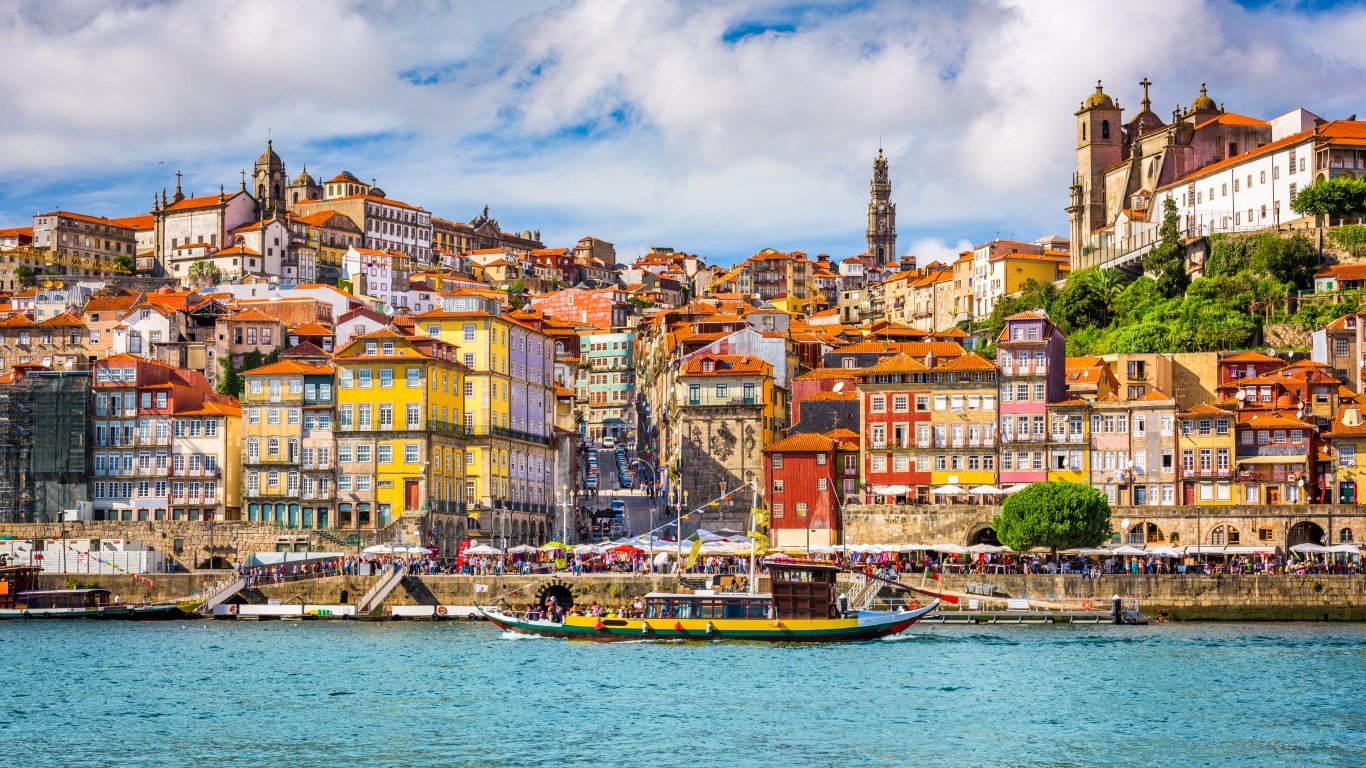
5. Portugal
> Annual energy consumption: 257 terawatt-hours (43rd of 44 countries reviewed)
> Annual energy production: 67 terawatt-hours (44th of 44 countries reviewed)
> Annual CO2 emissions from fuel combustion: 52.5 tons (41st of 44 countries reviewed)
> Electricity generated from renewable sources: 55.0% (8th of 44 countries reviewed)
> Population: 10.3 million
Like its neighbor, Spain, Portugal produces negligible amounts of crude oil, natural gas, and coal. Also like Spain, Portugal imports billions of dollars worth of crude oil, much of which is refined domestically. One refinery in the industrial port city of Sines accounts for over 70% of Portugal’s refining capacity.
Unlike Spain, however, Portugal has no nuclear power plants, and how its neighbor disposes of its nuclear waste is a source of tension between the two countries. Electricity in Portugal is primarily generated by renewable sources, including wind, solad, and hydro.

4. Italy
> Annual energy consumption: 1,733 terawatt-hours (17th of 44 countries reviewed)
> Annual energy production: 392 terawatt-hours (36th of 44 countries reviewed)
> Annual CO2 emissions from fuel combustion: 350.1 tons (18th of 44 countries reviewed)
> Electricity generated from renewable sources: 40.5% (13th of 44 countries reviewed)
> Population: 60.3 million
Italy produces only a small percentage of the total natural gas it consumes annually. Much of its natural gas imports come by pipeline from Russia. Though Italy has relatively small proved reserves of crude oil, it is one of the continent’s major refining hubs. Italy imported $35.1 billion of crude oil and exported $13.9 billion in refined petroleum in 2019.
The Italian government has heavily subsidized renewable energy production in the country in recent years, and as a result, between 2000 and 2016, the share of electricity generated by wind and solar climbed from 1% to 18%. Today, renewable sources, including hydro, account for over 40% of electricity production in the country.

3. South Korea
> Annual energy consumption: 3,467 terawatt-hours (6th of 44 countries reviewed)
> Annual energy production: 752 terawatt-hours (28th of 44 countries reviewed)
> Annual CO2 emissions from fuel combustion: 716.4 tons (7th of 44 countries reviewed)
> Electricity generated from renewable sources: 4.8% (40th of 44 countries reviewed)
> Population: 51.7 million
South Korea has limited natural energy resources, and as a result, the country of nearly 52 million people is one of the five largest importers of coal, natural gas, and petroleum in the world. The country imported over $67 billion of crude petroleum in 2019. Most of that oil came from Saudi Arabia, the United States, Kuwait, and Iraq.
A highly industrialized nation, electricity consumption in South Korea is driven by steel and petrochemical production. Currently, fossil fuels account for nearly 70% of electricity generation in the country, and renewable sources account for only about 5%. The government has set targets to generate 20% of electricity from renewable sources by 2030 and 30% by 2040.
[in-text-ad-2]

2. Japan
> Annual energy consumption: 4,895 terawatt-hours (5th of 44 countries reviewed)
> Annual energy production: 675 terawatt-hours (31st of 44 countries reviewed)
> Annual CO2 emissions from fuel combustion: 1151.9 tons (5th of 44 countries reviewed)
> Electricity generated from renewable sources: 18.0% (24th of 44 countries reviewed)
> Population: 126.3 million
Japan is one of the wealthiest countries in the world and boasts a highly developed, diversified, and large economy. The island nation, however, is scarce in natural resources for power production and consumes far more energy than it is able to produce. As a result, it depends on international trade for energy. About 90% of Japan’s energy needs are supplied from sources abroad.
For about half a century, much of Japan’s domestically produced energy has come from nuclear power plants. However, following the disaster at the Fukushima nuclear plant following the tsunami in 2011, Japan ceased all nuclear energy production. Reactors have begun reopening in 2015, and many others are slated to reopen soon. The country plans to generate at least 20% of its electricity from nuclear plants by 2030.

1. Taiwan
> Annual energy consumption: 1,276 terawatt-hours (23rd of 44 countries reviewed)
> Annual energy production: 130 terawatt-hours (43rd of 44 countries reviewed)
> Annual CO2 emissions from fuel combustion: 309.0 tons (21st of 44 countries reviewed)
> Electricity generated from renewable sources: 6.1% (39th of 44 countries reviewed)
> Population: N/A
According to the Taiwanese government, about 98% of the country’s energy demand is met through international trade, rather than domestic production. With limited natural resources, the country imported nearly $25 billion of crude petroleum, and $7.4 billion of natural gas in 2019. Though the country has oil refineries, they are aging and prone to accidents, and partially as a result, Taiwan also imported nearly $7 billion in refined petroleum in 2019.
Coal and natural gas account for the bulk of electricity production in Taiwan, with renewable sources accounting for only 6.1% of electricity generation.
Methodology
To determine the countries that consume more resources than they produce, 24/7 Wall St. reviewed data from Enerdata’s Global Energy Statistical Yearbook 2020. Countries were ranked based on the ratio of total energy consumption to total energy production in 2019. Of the 44 countries covered by Enerdata, only those with a ratio greater than 1 were included. Data on consumption and production of oil, natural gas, and coal and lignite also came from Enerdata. Data on population totals came from the World Bank and is for 2019. We also considered supplemental data from the U.S. Energy Information Administration and BACI, an international trade database.
Sponsored: Want to Retire Early? Here’s a Great First Step
Want retirement to come a few years earlier than you’d planned? Or are you ready to retire now, but want an extra set of eyes on your finances?
Now you can speak with up to 3 financial experts in your area for FREE. By simply clicking here you can begin to match with financial professionals who can help you build your plan to retire early. And the best part? The first conversation with them is free.
Click here to match with up to 3 financial pros who would be excited to help you make financial decisions.
Thank you for reading! Have some feedback for us?
Contact the 24/7 Wall St. editorial team.
 24/7 Wall St.
24/7 Wall St. 24/7 Wall St.
24/7 Wall St. 24/7 Wall St.
24/7 Wall St.


